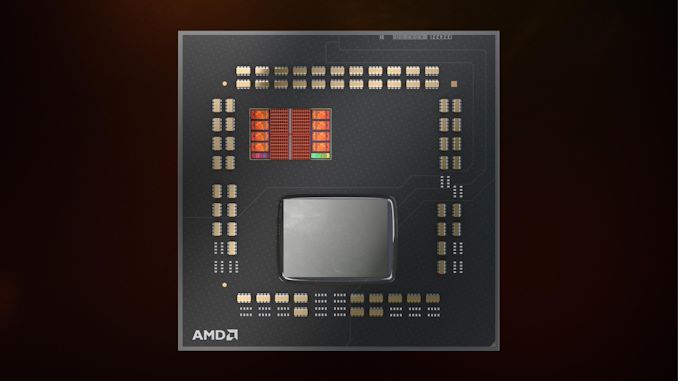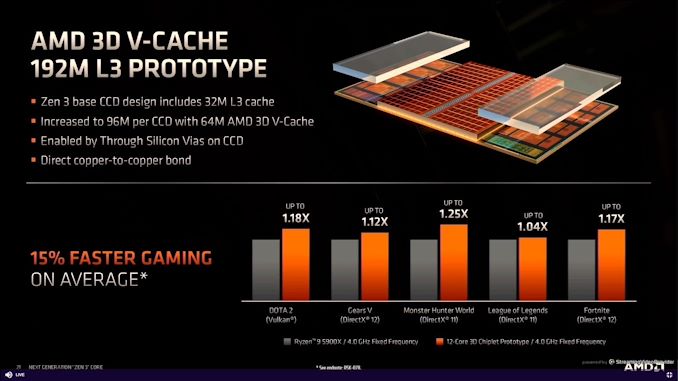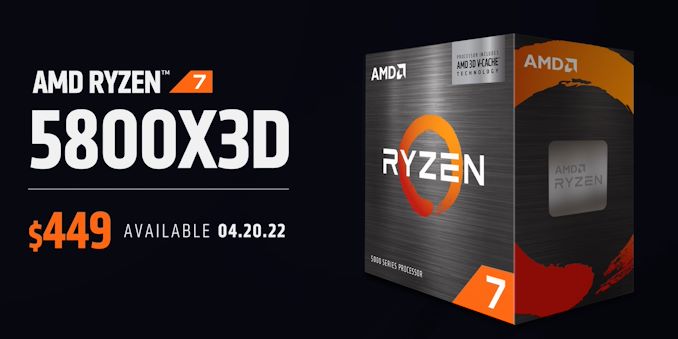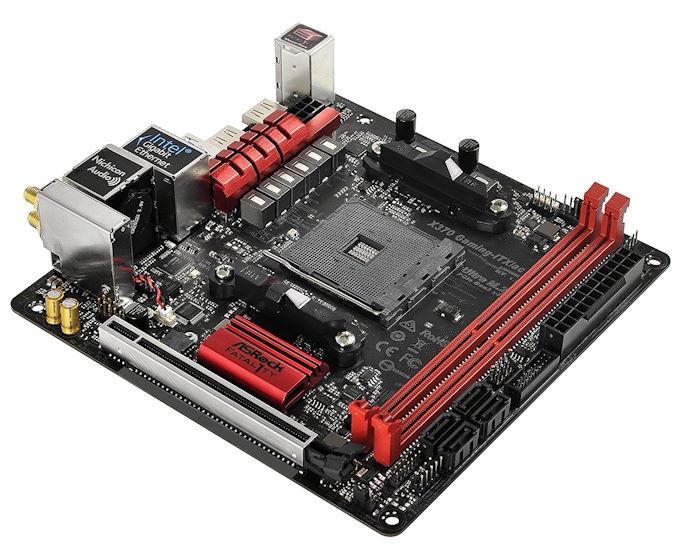AMD's Ryzen 7 5800X3D Launches April 20th, Plus 6 New Low & Mid-Range Ryzen Chips
by Ryan Smith & Gavin Bonshor on March 15, 2022 9:00 AM EST
Since the launch of AMD’s Zen 3-powered Ryzen 5000 desktop processors in late 2020, the company’s retail desktop chip offerings have been rather static. With AMD facing heavy demand for products on multiple fronts – from CPUs to GPUs to console APUs – and all during an unprecedented chip crunch, the company has held back on expanding its desktop offerings. Instead, AMD has focused its limited TSMC 7nm wafer allocations on trying to keep up with demand for some of their most important (and highest margin) products, such as server CPUs, laptop chips, and high-end desktop CPUs.
However, as the chip crunch has ever-so-slightly abated, AMD is now turning their attention back to the desktop space, to finally focus on fleshing out their desktop processor product lineups. We saw our first glimpse of that last week with the announcement of the long-awaited Threadripper Pro 5000 series for workstations. And now for this week the company is announcing the launch dates of several new Ryzen desktop processors.
Leading the charge is AMD’s new Ryzen 7 5800X3D. Previously announced at CES 2022 with a “spring” launch timeframe, the 5800X3D is perhaps the most interesting desktop chip design to come out of AMD in the last few years, thanks to its inclusion of additional L3 cache in the form of AMD’s die-stacked V-Cache. AMD is specifically pitching this 8 core processor as the ultimate chip for gaming – on the basis that gaming performance benefits in particular from the extra L3 cache – and will be releasing it on April 20th for $449.
Meanwhile, AMD is also using this moment to finally fill out the lower half of what would be its traditional chip product stack, which up until now stopped with the relatively powerful hex-core Ryzen 5 5600X at $230. Altogether AMD is launching 6 new processor SKUs to fill out the sub-$300 segment, including a pair of 6-core Zen 3 CPUs and an 8-core Zen 3 CPU. More unusually, the other 3 parts are new Zen 2 chips, which are being used to round out their cheapest processors. One of these SKUs includes an APU and will be sold under AMD’s Ryzen 4000 product line, with sales expected to start on April 4th.
Finally, in a move as equally unexpected as launching new Zen 2 SKUs in 2022, AMD is also finally relenting on enabling official support for Ryzen 5000 processors on AMD’s older 300 series chipsets. Though the company has long declined to support the newest Zen 3 chips on these older chipsets, almost a year and a half later AMD is finally changing their tune, and will be releasing (and supporting) the necessary code to motherboard manufacturers to add support for the chips in new BIOSes. To that end, Ryzen 5000 support should start appearing in beta BIOSes in April and May.
Ryzen 7 5800X3D: “The World’s Fastest Gaming CPU”
Headlining today’s announcements from AMD is the announcement of a release date for the company’s innovative Ryzen 7 5800X3D. This chip and its full specifications was announced back as part of AMD’s CES 2022 presentation, though at the time AMD was still ramping up production for a spring launch. Now spring has nearly sprung, and the Ryzen 7 5800X3D’s launch date has been locked down to April 20th.
When it launches, the 5800X3D will be just the second chip from AMD to launch with V-Cache, following the Milan-X family, which at last check is still expected before the end of this month. The 5800X3D, in comparison to the massive Milan, is a fair smaller-scale deployment of AMD’s cache stacking technology. But none the less it is the first desktop processor to receive the technology, and will be our first real taste at what adding all of that extra L3 cache can do for AMD’s Zen 3 CPU architecture.
| AMD Ryzen 5000 Series Processors for Desktop (>$200) Zen 3 Microarchitecture (Non-Pro, 65W+) |
|||||||||
| AnandTech | Core/ Thread |
Base Freq |
1T Freq |
L3 Cache |
iGPU | PCIe | TDP | SEP | |
| Ryzen 9 5950X | 16 | 32 | 3400 | 4900 | 64 MB | - | 4.0 | 105 W | $590 |
| Ryzen 9 5900X | 12 | 24 | 3700 | 4800 | 64 MB | - | 4.0 | 105 W | $450 |
| Ryzen 9 5900 | 12 | 24 | 3000 | 4700 | 64 MB | - | 4.0 | 65 W | OEM |
| Ryzen 7 5800X3D | 8 | 16 | 3400 | 4500 | 96 MB | - | 4.0 | 105 W | $449 |
| Ryzen 7 5800X | 8 | 16 | 3800 | 4700 | 32 MB | - | 4.0 | 105 W | $350 |
| Ryzen 7 5800 | 8 | 16 | 3400 | 4600 | 32 MB | - | 4.0 | 65 W | OEM |
| Ryzen 7 5700X | 8 | 16 | 3400 | 4600 | 32 MB | - | 4.0 | 65 W | $299 |
| Ryzen 5 5600X | 6 | 12 | 3700 | 4600 | 32 MB | - | 4.0 | 65 W | $230 |
As a quick refresher, the cache-heavy chip will have a single Zen 3 CPU core chiplet with all 8 cores enabled, and the extra 64MB of V-Cache stacked on top for a total of 96MB of L3 cache. AMD is essentially treating this as a larger cache version of the current 8-core 5800X, however clockspeeds are going to be a bit different. The 5800X3D will have a base clockspeed of 3.4GHz and a turbo clockspeed of 4.5GHz, both reduced a bit from the regular 5800X. According to AMD, this is because they’ve opted to hold the chip’s TDP at the same 105W level as the original, and thus clockspeeds had to be dialed down some to accommodate the power consumption of the additional cache.
In either case, AMD has decided to go after the gaming market with their beefy 8-core CPU. As detailed by the company back at CES 2022 and reiterated in today’s announcement, AMD has found that the chip is 15% faster at gaming than their Ryzen 9 5900X. As our own Dr. Ian Cutress noted at the time: “The extra cache is meant to help with communications with discrete graphics cards, offering additional performance above the regular R7 5800X. Productivity workloads are less likely to be affected, and for those users the regular Ryzen CPUs are expected to be better.”
And, perhaps most critically, we now have a price for the chip: $449. The price comes as AMD recently enacted what appears to be an across-the-board price cut for their Ryzen 5000 desktop chips, which among other things saw the original 5800X drop from around $400 to $350. At current prices, this means the 5800X3D and its extra 64MB of L3 cache carry a $100 premium, which is a stiff increase for just the performance unlocked by a larger cache. But it may prove more than worth it if it’s enough to truly vault the chip into the top spot for gaming workloads.
In practice, I expect the 5800X3D to live (or die) based on pricing. AMD’s 12-core Ryzen 5900X is also $449, so buyers who are willing to part with that money will be choosing between 4 more CPU cores or a single Zen 3 chiplet with 64MB more L3 cache. This gives the 5800X3D a very narrow scope to excel at, since most workloads that can put 8 cores to good use can do even better with 12. Games are one of the only exceptions to this rule: not only are multiplatform games designed against 8 core CPUs to begin with, but out of necessity they often have one heavily-serial master thread that bottlenecks efforts efforts to spread out work over a large number of cores.
In any case, gamers will get a chance to get their hands on the chip in just a bit over a month, when it goes on sale on April 20th. Like AMD’s other X chips, this one doesn’t come with a cooler, so you’ll have to bring your own for this launch.
Expanding Down: 6 New Ryzen 5000 CPUs & Ryzen 4000 APUs
As well as launching a new high-end gaming chip, AMD is also using events over the next few weeks to finally fill out the lower half of their chip product stack. Since the launch of the Ryzen 5000 series back in November of 2020, the cheapest chip AMD has offered is the 6-core Ryzen 5 5600X, which even following recent price cuts is still $229. Due to AMD being constrained by the ongoing chip crunch, the company has been opting to put its limited allocations into higher-end products, which are more profitable than the kind of lower-margin products that make up the sub-$200 market.
This has left Intel with essentially free reign of the low-to-mid-range market for the last several months. While the boys in blue are not entirely insulated from the chip crunch either, by owning their own fabs Intel isn’t competing with other vendors for wafer allocations. Consequently, Intel has been the only vender shipping chips suitable for the sub-$200 market for the better part of the last year.
But Intel’s uncontested dominance of that market is set to finally come to an end in early April, when AMD launches several new Ryzen chip SKUs to flesh out their sub-$300 line. With the new chips ranging in price from $99 to $299 and offering between 4 and 8 cores, AMD is very clearly lining themselves up to go against Intel’s full 12th Gen Core (Alder Lake) product stack.
Unlike the 5800X3D, there aren’t any novel features to talk about here – these are just new SKUs based on existing chip designs – so the new chips are relatively straightforward. None the less, there are some interesting things going on here with respect to what architectures and dies AMD has opted to use – particularly the introduction of new Zen 2 SKUs in 2022.
| AMD Ryzen 4000/5000 Series Processors for Desktop (<$300) | ||||||||||
| AnandTech | Core/ Thread |
Base Freq |
1T Freq |
L3 Cache |
CPU uArch |
iGPU | PCIe | TDP | SEP | |
| Ryzen 7 5700X | 8 | 16 | 3400 | 4600 | 32 MB | Zen 3 | - | 4.0 | 65 W | $299 |
| Ryzen 5 5600X | 6 | 12 | 3700 | 4600 | 32 MB | Zen 3 | - | 4.0 | 65 W | $230 |
| Ryzen 5 5600 | 6 | 12 | 3500 | 4400 | 32 MB | Zen 3 | - | 4.0 | 65 W | $199 |
| Ryzen 5 5600G | 6 | 12 | 3900 | 4400 | 16 MB | Zen 3 | Vega7 | 3.0 | 65 W | $210 |
| Ryzen 5 5500 | 6 | 12 | 3600 | 4200 | 16 MB | Zen 3 | - | 3.0 | 65 W | $159 |
| Ryzen 3 5300G | 4 | 8 | 4000 | 4200 | 8 MB | Zen 3 | Vega6 | 3.0 | 65 W | OEM |
| Ryzen 5 4600G | 6 | 12 | 3700 | 4200 | 8 MB | Zen 2 | Vega7 | 3.0 | 65 W | $154 |
| Ryzen 5 4500 | 6 | 12 | 3600 | 4100 | 8 MB | Zen 2 | - | 3.0 | 65 W | $129 |
| Ryzen 3 4100 | 4 | 8 | 3800 | 4000 | 4 MB | Zen 2 | - | 3.0 | 65 W | $99 |
We’ll start with the new Ryzen 5000 series chips, the Ryzen 7 5700X, Ryzen 5 5600, and Ryzen 5 5500. Like the rest of the 5000 series, these are all based on the Zen 3 architecture, and based on the specifications look to be using a single Zen 3 CPU core chiplet. With 6 cores each, the $199 5600 and $159 5500 are designed to bring the 5000 series family down to the ~$150 price point.
With 3 6C processors in its lineup, AMD isn’t going to be differentiating these parts much on the basis of clockspeed. The 5600 is clocked a couple of hundred MHz lower than the existing 5600X, and the 5500 a bit lower still. Instead, the defining difference for the 5500, being the cheapest chip, is that it’s also giving up some L3 cache and PCIe 4 functionality. This chip will instead have 16MB of L3 cache (half as much as usual), and its PCIe links will be limited to PCIe 3.0 speeds. So the additional cache and PCIe 4.0 functionality will remain a premium feature (of sorts) for the 5600 and up (and consequently, I wouldn't be surprised if 5500 is really a Cezanne chip).
Meanwhile the Ryzen 7 5700X is the odd member of the group, as it’s not meant to extend the Ryzen range so much as it is meant to fill some holes. The 8 core chip will be priced at $299, giving AMD their first sub-$300 8C chip in a while, and offering something stronger to fend off Intel’s 6+4 core i5-12600K at this price point. I expect this will prove a very tempting chip for buyers looking to save a few bucks, as it offers the same 32MB of L3 cache as the 5800X, and the top turbo clockspeed is only 100MHz below AMD’s better-known 8C chip.
Finally, in order to bring AMD’s current retail product stack below the $159 mark, AMD is also re-enlisting some Zen 2 hardware. Specifically, almost 2 years after AMD first launched their Renior-based Zen 2 APUs for the OEM desktop market, we’re finally getting 7nm Renoir in the retail desktop market, albeit with mostly new SKUs. And, in keeping consistency with the hardware and the branding, these new chips will be sold as part of the Ryzen 4000 family – thereby marking the first time the Ryzen 4000 family has been available at retail.
First off, we have the Ryzen 5 4600G, a true APU that up until now has only been available to OEMs. This part offers 6 Zen 2 CPU cores combined with AMD’s RX Vega 7 (7 CU) graphics. The top turbo clockspeed of 4.2GHz combined with Zen 2’s lower IPC means there’s going to be a noticeable gap in CPU performance between this and the Ryzen 5 5500. Still, if you need a cheap Ryzen chip with integrated graphics, then the 4600G will be your one and only option for an AMD APU with an iGPU.
Below the 4600G we have two new SKUs from AMD, the $129 Ryzen 5 4500, and the $99 Ryzen 3 4100. And while both of these parts would seem to be based on Renoir as well, AMD has disabled the iGPUs on these parts. So they are essentially APUs-sans-graphics, the first time we’ve seen AMD do this with the Ryzen 4000 series. From a practical perspective, it looks like AMD is using these SKUs to finally sell off Renoir dies that have completely faulty graphics, with AMD having the last two years to stockpile those chips.
The Ryzen 5 4500 is a 6C part with a base clockspeed of 3.6GHz and a turbo clockspeed of 4.1GHz, both of which are 100MHz below the 4600G. Otherwise, the chip gets the same 8MB of L3 cache. Finally, the Ryzen 3 4100 offers just 4 Zen 2 cores, which are clocked at 3.8GHz base and 4.0GHz turbo. With one of Renoir’s two CCXes disabled, it offers just 4MB of L3 cache. Both of these chips will be going up against Intel’s Core i3 lineup, with the 4100 facing off against the equally iGPU-less i3-12100F.
All of the new Ryzen 5 and Ryzen 3 SKUs will be paired with AMD’s Wraith Stealth cooler, and will hit the streets on April 4th. Meanwhile the Ryzen 7 5700X will skip the cooler, but it will hit the streets on the same date as the rest of the chips.
Official Ryzen 5000 Support for AMD 300 Series Chipsets
AMD’s final product-related announcement of the morning focuses on motherboards – and specifically, older motherboards.
After almost a year and a half since the launch of AMD’s first Ryzen 5000 (Zen 3) CPUs, AMD is finally bringing official support for the newest Ryzen CPUs to AMD’s older Zen/Zen+ 300 series chipsets. Since AMD has used the same socket AM4 throughout the entire run of the Ryzen family of chips thus far, Ryzen 5000 chips have always been able to fit and electrically work in older motherboards. However, those older boards have lacked the necessary BIOS support to boot the chips.
All of this has made adding support for the newest Ryzen chips a longstanding request from existing AMD users, to give them an upgrade path for their existing boards. But it’s also one AMD has been less than eager to deliver on, as the 300 series chipset is multiple generations older than the Ryzen 5000 chips. Even AMD’s support for Ryzen 3000 CPUs on the 300 series chipset has been piecemeal at best.
But all of this is finally changing, starting next month. AMD is finally bringing a degree of official support for the Ryzen 5000 family on AMD 300 series chipset motherboards, starting with AGESA 1.2.0.7. For 300 series chipset motherboards, that version of AMD’s BIOS module will add what the company is terming “beta” support for the Ryzen 5000 family. For those boards that can meet Ryzen 5000’s power requirements, it will be possible to boot the chips in conjunction with the new AGESA.
This will however require that motherboard manufacturers roll out new BIOSes for their 300 series motherboards, which at this point are two generations old (and have been since late 2019). So any such updates are almost certainly to be piecemeal – popular motherboards from top-tier manufacturers are more likely to get the necessary BIOS update than lesser-known motherboards. So while AMD is making the necessary AGESA available to all of the vendors, no one is expecting Ryzen 5000 support to become universal across 300 series motherboards.
Overall, this is a very similar strategy to how AMD has handled Ryzen 3000 (Zen 2) CPU support for 300 chipset series motherboards. There was never universal support there either, but there was beta support for motherboard vendors that opted to add it.
According to AMD, users should expect to see BIOSes with Ryzen 5000 support in an April-to-May timeframe. Since BIOS updates are the domain of the motherboard manufacturers themselves, the specific timing will be up to the latter group and when they opt to release updated BIOSes.
















98 Comments
View All Comments
nikaldro - Tuesday, March 15, 2022 - link
Hex-core, the processor that will turn you into a frogmode_13h - Tuesday, March 15, 2022 - link
Intel used number their CPU models, until they lost some sort of trademark case and decided to use actual names. That's when they first introduced Pentium, as the successor to the i486. With Penta being the Greek prefix for 5, those who didn't know their Latin from their Greek would joke that the following generation CPU should be called the Sexium.Of course, Intel probably didn't much fancy Hexium either, since they stayed stuck on Pentium-based names until the somehow even worse-named "Core" branding. And that would later be outdone by their Xe branding for GPUs, which is the chemical symbol for the element Xenon -- far too easily confused with their Xeon branding of server/workstation CPUs. I digress...
Jasonovich - Wednesday, March 16, 2022 - link
I had a good chuckle, thanks!Oxford Guy - Wednesday, March 16, 2022 - link
Not to mention that xenon was once classified under ‘inert’ — which reminds of the apocryphal tale of the ‘no go’ Chevrolet Nova.Perhaps worse yet is that the compounds made with Xenon are all much too unstable to survive outside of very specific controlled conditions — as with Intel’s industrial chiller it used to demo its 28 core 14nm 5 GHz ‘Oops, we forgot’ CPU.
Jasonovich - Wednesday, March 16, 2022 - link
Let's hope the princess isn't a toad :)dwillmore - Tuesday, March 15, 2022 - link
"In practice, I expect the 5800X3D to live (or die) based on pricing. AMD’s 12-core Ryzen 5900X is also $449, so buyers who are willing to part with that money will be choosing between 4 more CPU cores or 64MB more L3 cache."It's just 32MB more L3 cache as it's 64MB for the 5800X and 96MB for the 5800X3D since the 5900X is a dual (6 core) die setup each with the full 32MB of L3 where the 5800X3D is a single 8 core die with 32MB of L3 and 64MB of V-Cache (or whatever they're calling it).
It really makes the 5900X look like the better choice. The 5800X3D is clocked more like a 5700X after all.
kobblestown - Tuesday, March 15, 2022 - link
In practice, I expect the 5800X3D to perform better than the 5900X on all tasks that do not peg all 12 cores to 100%. And will be noticably better on all lightly threaded tasks. So a better fit for at least 90% of people that can spare that kind of dosh.Also, it would be interesting to see how it overclocks. If it OCs at least as well as the 5900X it's an instant purchase for me (coming from a 3600X). Otherwise I might look at 5700X/5800X as better bang for buck options.
edzieba - Tuesday, March 15, 2022 - link
Signs so far point to the 5800X3D being non-overclockable (or at least not officially). Not a surprise with having the manage clocks across a bus that spans multiple dies without an explicit interconnect interface.Targon - Tuesday, March 15, 2022 - link
That whole "leak" strikes me as a bit of a joke, for a very basic reason, CPU abilities are enabled/disabled based on the BIOS. If the current AGESA versions do not allow for overclocking due to AMD wanting to keep the leaks from revealing too much, then that would make a lot more sense than not allowing overclocking at all. At CES and the interviews after it, it was strongly hinted that if you put better cooling on the 5800X3D, it will overclock up to the same speeds as the regular 5800X, but that will obviously go over the TDP rating of the CPU.AMD has actually played with the leak community over the years by releasing different samples to different places, just to see where the leaks come from. If the leaks line up with the version that went to Asus for example, then bingo, the leak comes from there, and AMD can respond properly. That is why the true leaks about Zen4 have been very few and far between.
haukionkannel - Thursday, March 17, 2022 - link
It has been confirmed. The 3d cache is the part that prevents OC in this cpu. The cache does not handle overclocking at all, so PBO and other kind of OC is prevented to protect the cache.